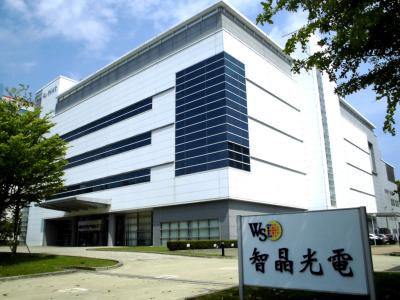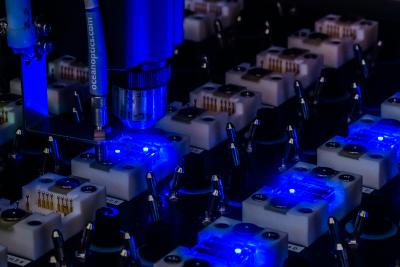TADF OLED emitters, introduction and market status - Page 6
Eternal Material Technology starts to construct its 15-ton OLED material plant, updates on its OLED material and TASF project
China-based Eternal Material Technology (EMT) announced that it has started to construct its 15-tons OLED material production facility in Hefei. Yesterday the company held a groundbreaking ceremony at the construction site. EMT company expects the plant to begin mass producing materials in the second half of 2021. The planned total investment of the project (which will also include production of other materials) is 500 million yuan (or around $72 million USD).

EMT says that it has been able to achieve design wins for its ETL materials, and also other OLED related materials - and has already achieved sales of over 230 million Yuan ($33 million USD). EMT offers over 20 different OLED materials.
Kyulux updates on its latest Hyperfluorescence TADF emitter performance
Kyulux presented a new paper at SID Displayweek, that shows the latest progress of the company's Hyperfluorescence OLED emitter platform. You can see the latest performance chart below.
Hyperfluorescence combines TADF and fluorescence emitters, which enables high-efficiency (~100% IQE) emitters that feature long lifetimes and a very narrow emission spectrum. The company's yellow HF emitter is already commercialized, and now Kyulux says that its red and green materials are "close to commercialization". The company is also improving the color point and lifetime of its HF blue emitters.
Noctiluca continues to improve its TADF emitter platform
This is a sponsored post by Noctiluca
Poland-based TADF developer Noctiluca reports that the company continues to improve its emitter platform, and the company recently concluded testing a new family of emitters that have revealed great TADF properties, good to excellent QY and blue emission. Noctiluca released the raw data (available from company under the NDA) that details the performance of several new blue emitters. Here is a link to the summary of these results.
Noctiluca’s Team have a history of making custom high purity compounds to specific needs, and its TADF compound family has a high level of customization which will allow the company to tailor its materials for specific OLED stacks. In fact the company's next step is to work with industry leaders and OLED material developers to test its materials within commercial-grade OLED stack architectures to continue its development work and enhance the performance of its OLED emitters.
A Q&A with Dr. York Tsai, Wisechip's Vice President of R&D
WiseChip Semiconductor, based in Taiwan, is one of the world's leading PMOLED maker (in fact in 2015 Wisechip said it's the world's second largest). Wisechip is developing next-generation PMOLED displays, including flexible panels, transparent panels and Hyperfluorescence/TADF PMOLEDs.

WiseChip recently announced its first, and the world’s first, Hyperfluorescence display, using TADF materials provided by Kyulux. Can you tell some more about this display and its properties?
This 2.70 128x64 product is adopted mostly in industrial products. The size matters in such market but the main problem was to increase the brightness due to the limited efficiency of the fluorescence emitters. The Hyperfluorescence technology helps to settle the problem and can reach up 2.5 times brighter. It performs much better readability so users do not have to stand right in front of the device. This feature adds to the value of the end product.
Kyulux announces first shipment of OLED TADF emitters to Wisechip
TADF emitter developer Kyulux announced that it has shipped the first batch of its yellow TADF emitter to Taiwan's Wisechip to be used it the world's first TADF / Hyperfluorescence display, the 2.7" PMOLED announced in October 2019 - which means that the display will likely start to ship soon.

Wisechip's first HF PMOLED is a 2.7" 128x64 monochrome yellow display, that reaches a brightness of 220 nits - 2.5 times brighter than Wisechip's fluorescent yellow PMOLED. The lifetime of this display is 50,000 hours. Wisechip says this display is aimed for the medical, industrial and electronic products markets, and in the future it will launch TADF/HF PMOLEDs for the wearable and consumer electronics markets as well.
Canon may start producing OLED materials
Canon announced that the company is looking into entering the OLED materials market. The company says its Fukui Canon Materials subsidiary will take the lead on this project, together with Canon's own R&D team.
Canon did not disclose what kind of OLED materials will be produced, but Canon has some TADF patents and it could look into TADF emitters.
A Q&A with Cynora's CEO, to discuss the company's new blue emitter
OLED material developer Cynora recently announced its first commercial product, the cyBlueBooster fluorescent blue emitter that is 15% more efficient that current fluorescent blue emitters on the market.

This was a very interesting announcement, and Cynora's CEO Adam Kablanian was kind enough to answer a few questions we had to help understand the new material and Cynora's current business and latest technology.
Cynora announces a new blue fluorescent emitter that is 15% more efficient than current emitters
OLED material developer Cynora announced its first commercial product, a fluorescent blue emitter that is based on an "advanced molecular design" that is 15% more efficient that current fluorescent blue emitters on the market. Cynora brands its new material as cyBlueBooster, and it says it is currently available for commercialization in several shades of blue.

This could be very exciting news - while the whole industry is looking for next-generation emitters using TADF or PHOLED technologies, Cynora could have found an easier path to reduce power consumption by 15%. OF course a TADF or PHOLED emitter will achieve a reduction of 75% in power consumption compared to currently-used fluorescent emitters.
TADF OLED emitter technology - industry status
TADF, or Thermally Activated Delayed Fluorescence, is a relatively new class of OLED emitter materials that promise efficient and long-lifetime performance without any heavy metals. TADF research started at around 2012, originally at Kyushu University in Japan and today many academic groups and several commercial companies are developing TADF materials.

The main reason companies are interested in TADF emission is that it could lead to an efficient and long-lasting blue OLED emitter - something that hasn't been yet achieved by other means (mainly - UDC's Phosphorescent OLED emitter technology). In recent years companies initiated commercial development of red, green and yellow TADF emitters as these can offer a lower cost alternative to UDC's PHOLEDs materials.
Idemitsu Kosan and Toray developed a red TADF/HF device that is the world's most efficient OLED emitter
Idemitsu Kosan and Toray Industries announced that the companies have jointly developed a red OLED device that is the world's most efficient emitter at 46 cd/A. The device uses a TADF emitter combined with red fluorescent materials (which likely means this is a HyperFluorescence device).
Idemitsu and Toray has been collaborating on OLED material development since 2017. This new device uses Idemitsu's TADF material combined with Toray's new red fluorescent material. The two companies say that this new material provides the same results as currently used red phosphorescent devices, and the plan is now to "drive forward to secure adoption of their materials" in mobile and TV applications.
Pagination
- Previous page
- Page 6
- Next page



